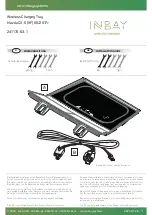
Camber
Camber is the tilting of the front wheels from
the vertical, as viewed from the front of the car.
When the wheels tilt outward at the top, the
camber is positive. When the wheels tilt inward
at the top, the camber is negative. The amount
of tilt is measured in degrees.
CENTER LINE
OF
Fig. 18-35
CAMBER ANGLE
‘POSITIVE
CAMBER
Toe Adjustment
1. Before making any adjustment affecting toe
setting, the following checks and inspections
should be made to insure correctness of
alignment readingsand alignment adjustments:
1) Check all tires for proper inflation pressures
and approximately the same tread wear.
2) Check steering and suspension system for
looseness. If excessive looseness is noted, it
must be corrected before adjusting.
3) Check for run-out of wheels and tires.
4)Consideration must be given to excess loads,
such as tool boxes. If this excess load is
normally carried in the car, it should remain
in the car during alignment checks.
5) Consider condition of the equipment being
used to check alignment and follow manufac-
ture’s instructions.
6) Regardless of equipment used to check
alignment, the car must be on a level surface
both fore and aft and transversely.
7) Check to be sure that front wheels are set in
straightforward driving position.
2. Toe is adjusted by changing tie rod length.
Loosen tie rod end lock nuts first and then
rotate turnbuckle
to align toe-in to specifi-
cation. At this time, thread length “A” and
“B” should be equal. After adjustment,
tighten lock nuts to specified torque.
Toe-in gauge
Fig. 18-36
Camber and Caster Adjustment
Should camber or caster be found out of specifi-
cations upon inspection, locate its cause first. If
it is in damaged, loose, bent, dented or worn
suspension parts, they should be replaced. If it is
in chassis frame (car body), repair it so as to
attain specifications.
To prevent possible incorrect reading of camber
or caster, car front end must be moved up and
down a few times before inspection.
Reference Information:
SIDE SLIP:
For inspecting front wheel side slip with side slip
tester:
Side slip limit:
Less than 3 mm/m
(Less than 0.118 in/3 ft)
If side slip exceeds this limit, toe-in or front
wheel alignment may not be correct.
18-17
Содержание Samurai 1986
Страница 1: ......
Страница 9: ...0 9...
Страница 10: ...0 6...
Страница 11: ...0 7...
Страница 12: ...0 8...
Страница 13: ...0 9...
Страница 14: ...0 10...
Страница 15: ...0 11...
Страница 19: ...1 2...
Страница 20: ...1 3...
Страница 119: ...r a l I 29 Fig 4 1 1 Carburetor exploded view 4 3...
Страница 120: ...N Fig 4 l 2 Carburetor cross section 4 4...
Страница 154: ......
Страница 155: ...T c c x 5 5 3...
Страница 347: ...Fig 17 1 34 17 12...
Страница 348: ...17 13...
Страница 353: ...Fig 17 2 12 17 18...
Страница 354: ...17 19...
Страница 360: ...Fig 17 3 19 Fig 17 3 20 Fig 17 3 21 5 Fig 17 3 23 Ci Fig 17 3 24 Fig 17 3 22 17 25...
Страница 379: ...Steering Lower Shaft and Joint Universal joint rubber joint bolt Steering rubber ir Fig 18 31 11 0 18 0lb ft 18 15...
Страница 424: ...Fig 19 6 1 19 38 19 6 PARKING BRAKE...
Страница 448: ...20 13...
Страница 450: ...21 2...
Страница 475: ...22 5...
Страница 476: ...22 6...
Страница 477: ...22 7...
Страница 478: ...22 8...
Страница 479: ...22 9...
Страница 480: ......
Страница 481: ......
Страница 482: ...Prepared by SUZUKI MOTOR CO LTD Technical Department Automobile Service Division 1st Ed November 1987 Printed in Japan...
















































